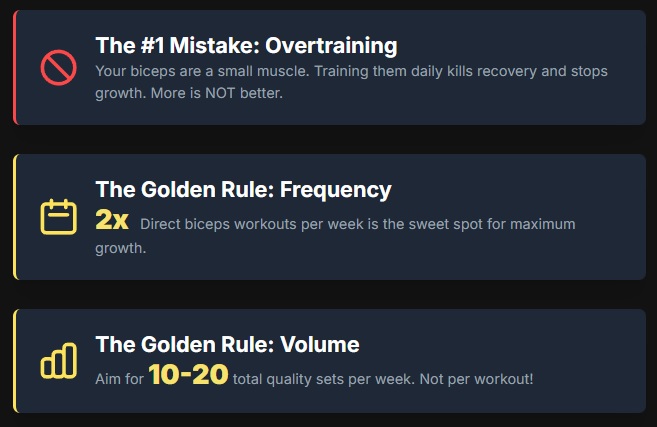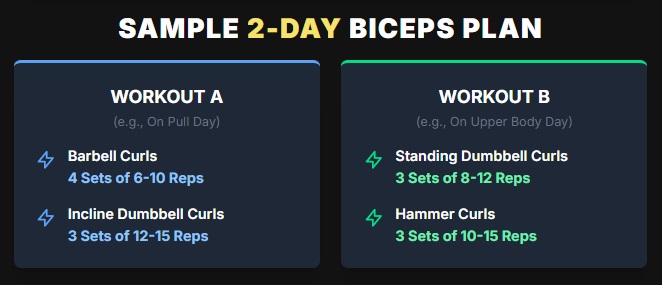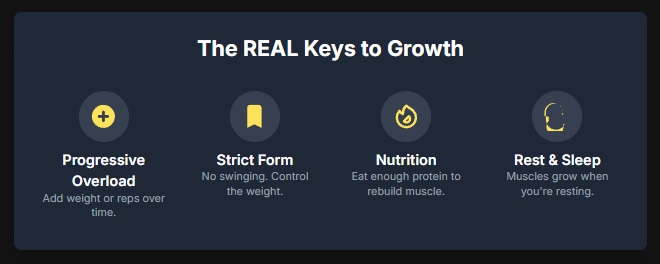The Ultimate Biceps Training Schedule for Serious Growth

Let’s be real for a second. You want bigger arms, and you're probably hammering away at curls, thinking more is better. I’m here to tell you that the perfect biceps training schedule isn’t about destroying your arms every day. It’s about being smart. I learned that the hard way, with sore elbows and arms that just wouldn't grow.

Why Your Biceps Aren't Growing (Hint: You're Trying Too Hard)
I remember my early days in the gym. I was obsessed. If the magazines said Arnold trained arms for two hours, then damn it, I would too. I did curls until I couldn't lift my water bottle. The result? Pain, frustration, and a serious lack of growth. My arms felt like overcooked spaghetti. Not a good look.
The truth is, your biceps are a relatively small muscle group. They get hit indirectly during a lot of other exercises - think rows, pull-ups, any pulling motion. Blasting them into oblivion with endless sets doesn’t give them time to do the one thing they need to do to grow: recover. Building muscle is like building a house. The workout is when you knock down the walls. The growth happens when you rebuild them stronger... and that takes time and materials (food and rest!). You can't rebuild while the demolition crew is still swinging sledgehammers.
The "How Often" Question: Finding the Sweet Spot
So, what’s the magic number? For most people, training biceps directly 2 times a week is the absolute sweet spot. Some advanced folks might get away with 3, but for 90% of us, twice a week is perfect. This gives the muscle enough stimulus to grow and enough time to fully recover before you hit it again.
Think about it. Would you rather have two amazing, high-quality workouts or four sloppy, half-hearted ones where you're just going through the motions because you're still sore from last time? It's a no-brainer. For a deeper dive on this, check out my post on how often beginners should work out, it applies to individual muscles too.
Building Your Biceps Training Schedule: A Simple Plan
Okay, enough theory. Let's put this into practice. A great approach is to pair your biceps training with a larger muscle group, like your back. Since you're already doing pulling motions for your back, your biceps are already warmed up and ready to go. Synergy, right?

Sample Weekly Split:
- Day 1: Pull Day (Back & Biceps)
- Day 2: Push Day (Chest, Shoulders, Triceps)
- Day 3: Leg Day
- Day 4: Rest
- Day 5: Upper Body Day (with Biceps focus)
- Day 6: Lower Body / Core
- Day 7: Rest
The Actual Biceps Workout: Quality Over Quantity
Here’s what you could do on your two biceps-focused days. Notice we aren't doing 10 different exercises. We're doing a few things and doing them well.
Day 1: After Your Back Workout
- Standing Dumbbell Curls: 3 sets of 8-12 reps. Focus on squeezing at the top and controlling the weight on the way down. Don't just swing it.
- Hammer Curls: 3 sets of 10-15 reps. This will also hit your brachialis, a muscle that adds thickness to your arm.
Day 5: Upper Body Day
- Barbell Curls: 4 sets of 6-10 reps. Go a little heavier here, but keep your form strict. A little bit of controlled "cheat" on the last rep is fine, but don't turn it into a back exercise.
- Incline Dumbbell Curls: 3 sets of 12-15 reps. This puts a great stretch on the bicep. You'll have to use lighter weight, so leave your ego at the door.
That's it. We're talking about a total of 13 sets for the entire week. It might not seem like much, but if you're training with intensity and focus, it’s more than enough to stimulate growth. Remember to focus on progressive overload - meaning you should be trying to lift a little heavier or do an extra rep over time. To understand how to manage that intensity, you should learn about lifting smarter, not just harder.

Stop Obsessing, Start Growing
Look, I get it. We all want impressive arms. But spending hours on curls is one of the biggest mistakes holding people back. Instead of adding another exercise, focus on improving the ones you're already doing. Control the tempo. Squeeze the muscle. Eat enough protein. Get enough sleep. Damn, this sounds simple, but it’s the stuff that actually works.
Give this smarter biceps training schedule a try for a month. Just one month. I promise you'll feel better, your elbows will thank you, and you’ll finally see the kind of progress you’ve been working so hard for.
- How many biceps exercises should I do per workout?
- For most people, 2-3 exercises are plenty. The key is to choose different types of curls that hit the muscle from slightly different angles, like a standard curl, a hammer curl, and maybe a concentration or incline curl.
- Can you train biceps 3 times a week?
- You can, but you need to be careful. If you choose to train them 3 times a week, you should lower the volume (total number of sets) in each session to avoid overtraining. For most beginners and intermediates, twice a week is more effective.
- How many sets should I do for biceps per week?
- A good range for optimal growth is between 10 to 20 total sets per week. If you're just starting, aim for the lower end of that range and gradually increase as you get stronger and more experienced.
- Is it okay to train biceps and triceps on the same day?
- Absolutely! This is a classic "arm day" split and it's very effective. It allows you to focus solely on arm development for that session, creating a huge pump and stimulating growth for both muscle groups.